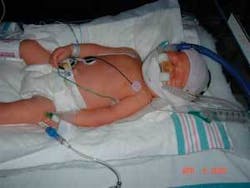Treating A Pregnant Patient
by Wendy S. Hupp, DMD
Your next patient arrives, and you greet her and ask about her health. She beams a beautiful smile and reports that she’s expecting a baby! How do you reassure her that the old wives’ tale of losing a tooth for every baby is not going to happen to her? What must you remember about dental treatment? Isn’t there a “best time” to treat her, and are there any restrictions?
Pregnancy changes
Several common things that take place during pregnancy can pose difficulty for a dental patient. Let’s call them alterations in normal physiology, and pregnancy-related pathology.
As a woman goes through the 40 weeks of a full-term pregnancy, her body adapts to the baby and works harder. Vital signs may show a slight increase as all systems work for two. In some cases, a dangerous elevation of blood pressure must be addressed quickly, and for some women, total bed rest is prescribed. This elevation in blood pressure during pregnancy is called preeclampsia or eclampsia in more severe cases. While many women see their obstetricians regularly, taking their blood pressure in a dental office provides another opportunity to intercept this potentially life-threatening condition before serious damage takes place to a woman or her baby.
Sometimes the increased blood volume and cardiac output during pregnancy leads to a heart murmur. This particular murmur does not need antibiotic premedication for dental treatment, but if a woman had a heart murmur before her pregnancy, the standard rules still apply. Other cardiovascular issues may arise: anemia, edema of the ankles, and shortness of breath are common but usually don’t need any special alterations of dental treatment.
As a baby grows, it pushes its mother’s stomach and diaphragm upward and her intestines decrease in motility. She may have an increased gag reflex that could cause problems for any procedure, especially impressions. Some women may have problems with gastroesophageal reflux and constipation. Wheezing may be a sign of acid reflux into the trachea and bronchi. Positional discomfort is evident in sleeping on one’s side or in a semi-reclining position.
Throughout pregnancy, hormones fluctuate. In some women, a change in pigmentation becomes evident as a mask across the malar areas of the face. Other changes include the loosening of the ligaments, especially in the pelvis and the knees, but also in the periodontal ligament. The development of pregnancy gingivitis and gingival granulomas is also believed to be caused by these changes in hormones.
Slight osteoporosis may develop in the jaw, although it’s likely that we do not have the equipment to measure these subtle changes. No calcium is lost from the teeth for the baby’s development, but it is possible that mom may lose some of her bone density to help supply the baby’s skeletal requirements.
Morning sickness is common and may cause permanent damage to the tooth enamel. The patient should rinse her mouth with water after vomiting rather than causing further damage with toothbrush abrasion.
As previously mentioned, pregnancy may lead to development or worsening of several oral problems such as gingivitis, pyogenic granuloma formation, erosion, and tooth mobility. Proper diagnosis of these conditions will lead to the right treatment, therefore increasing the mother and baby’s overall health.
Modifications of dental treatment
During a patient’s first trimester, initiate a preventive care program consisting of plaque control and oral hygiene instruction. Simple scaling and prophylaxis may be accomplished, but no elective treatment should be started. Only emergency dental needs should be considered during this trimester. The baby’s organs develop during this time and are most sensitive to radiation and chemicals. Proper radiograph technique using a lead abdominal shield and the lowest dose possible (fast film or digital) produce a fetal exposure that is extremely low, probably on the order of one ten thousandth the amount implicated in the alteration of genetic material, malformation, or spontaneous abortion. At no time and for no patient should radiographs be used cavalierly, but for many patients, the postponement of radiographs caters more to their emotional health. When indicated to treat an emergency, the fewest number of images necessary to obtain the correct diagnosis should be obtained.
The second trimester through the first half of the third trimester is the safest time to provide dental treatment. Periodontal maintenance and preventive care and simple restorative procedures that will eliminate potential problems and control active disease may be performed. Complex and elective dental care is best deferred until after the baby is born.
In the third trimester, scaling and prophylaxis may be repeated to minimize hormonal gingival changes. Supine position may cause the fetus to occlude the blood supply from returning to the heart, leading to a loss of consciousness. Elevation of the right hip of the mother in the dental chair will allow the inferior vena cava to stay patent and avoid this pooling of the blood in the legs. If she does start to feel faint, the patient should position herself on her side. Emergency dental treatment should be provided, as the mother’s severe pain, infection, or both can cause problems for the baby.
Safe medications
The most common drugs used by dentists have been shown to be safe for use in pregnancy with a few exceptions. Lidocaine with epinephrine is safe, but as with any patient, proper aspiration to avoid intravascular injection is necessary for effective anesthesia and to avoid the cardiovascular side effects of epinephrine. Too rapid a heartbeat and systemic vasoconstriction can lead to fetal hypoxia.
Penicillin, clindamycin, and cephalosporins are safe antibiotics and should be prescribed when indicated. Tetracyclines of any type should be avoided during pregnancy and breastfeeding to avoid any discoloration of the teeth.
Analgesia presents a more difficult decision, but acetaminophen is OK for most patients. Aspirin and other nonsteroidal, anti-inflammatory drugs (e.g., ibuprofen) should not be prescribed. For severe pain, oxycodone is considered safe. Codeine, hydrocodone, or propoxyphene are probably safe for a short time. Nitrous oxide is controversial but probably safe as long as there is oxygen administered as well.
The recent data on carbamide bleaching solutions continues to be cautious and it is not recommended during pregnancy. For more information about medications and their use in pregnancy, check any drug reference for the A, B, C, D, X classification. For drugs that have a C or lower rating, consultation with a physician is recommended.
When is a consultation necessary?
I ask pregnant patients several questions before I do any dental treatment.
- Are you seeing a physician for prenatal care?
- What is your due date?
- Have you had any previous complications of prior pregnancies?
- Is this considered a high-risk pregnancy?
A consultation with a physician is necessary if there are any irregularities or if a patient’s blood pressure is elevated above 140 over 90. I typically inform a patient’s obstetrician if I’m going to prescribe narcotics, and most OBs are grateful. My concern for the patient’s well-being as well as the baby’s allows the mom-to-be to feel relaxed and have confidence in the treatment. It is best to avoid any dental emergency, but efficient. compassionate care reduces stress. Healthy teeth and gums lead to better nutrition and reduce inflammatory chemicals in the body. There should be no teeth lost just because a woman has a baby.
References
- Xiong X, Buekens P, et al. Periodontal disease and adverse pregnancy outcomes: a systematic review. Obstetrical and Gynecological Survey 2006; 61(5):307-309.
- Offenbacher S, Boggess KA, et al. Progressive periodontal disease and risk of very preterm delivery. Obstetrics and Gynecology 2006; 107(1):29-36.
Periodontal Disease and the preterm, low-birth-weight baby
Since the first report of a connection between periodontal inflammation and complications in pregnancy was reported in the 1990s, there has been much speculation why. It remains to be seen how exactly, but the identification of inflammatory markers seems to be a strong candidate. Other research is needed with a much larger number of patients, and there are many variables with these women.
One recent review of 25 studies suggested an association between periodontal disease and adverse pregnancy outcomes, including miscarriage and preeclampsia.1 The Oral Conditions and Pregnancy (OCAP) study2 quantified the incidence of preterm birth at 11.2 percent among periodontally healthy women, compared to 28.6 percent in women with moderate to severe periodontal disease.
It is difficult to evaluate the sociological part of poor oral health, that is, how much are poor oral hygiene and poor dental care signs that other factors in systemic health are neglected? Is a person who doesn’t floss also avoiding proper nutrition, exercise, and health care? Periodontists are working closely with obstetricians to continue the search for etiologies.
PRACTICING PREGNANT
By Tamara S. Berg, DDS
Having children seemed natural, but for me and my husband, it has been a struggle. We spent years going through fertility tests only to be told we are “unexplained infertile.” Nevertheless, a pregnancy surprised us eight years into our marriage. I worked until my due date and took home the schedule with phone numbers - just in case I went into labor. I started contracting late on a Sunday evening and cancelled patients the morning of my son’s birth. My office staff sent postcard announcements to our patients. I assumed this is how all pregnancies occur for practicing dentists.
Karsten stayed at the practice 18 months, growing up in front of the patients. A college student stayed with him in an extra room, which allowed me to be at the office without always being by Karsten’s side. And his sitter loved being able to do homework and study while my son napped. Patients still ask to see how big Karsten has gotten because they remember being a part of his life. We have a tradition of letting patients guess the arrival day, time, and even the sex of babies belonging to me, my dental hygienist, and my receptionist. The patient closest to the time of delivery receives an Oral-B electric toothbrush. Patients love it.
The itch of another child came, and once again, my husband and I started fertility treatments. We went through in vitro fertilization, or IVF, twice in the summer of 2002 only to be told “not pregnant” after weeks of daily injections, ultrasounds during my lunch hour, and dollars spent. We were exhausted. My desire to have another child never left, and two years later, we consulted our fertility doctor again to give it one more try. The IVF was the same with the injections, lunch-hour visits for drawing blood and ultrasounds, removal of eggs, and the transfer of embryos. Six of seven eggs had fertilized correctly. The lab called daily to update us on the embryos. We were down to five viable embryos, and the lab wanted to surgically implant them the following day. We arrived at the hospital to four remaining embryos. After consulting our doctor, we placed three. Bed rest followed for 72 hours. I woke up early and took a home pregnancy test. It was positive. My husband couldn’t believe I took a home test; I had always waited for the clinic to tell me. We had to wait a few more weeks to find out by ultrasound if there were one, two, or three babies. Our first ultrasound showed two implanted embryos, but only one was developing correctly. The doctor said the second embryo was more than likely a vanishing twin that would not survive; it would be gone by the next ultrasound. I was happy for an embryo forming correctly but sad that we were losing a potential child. A second ultrasound two weeks later confirmed it was gone. It was time to transfer to an OB-GYN.
I could wean myself from the daily injections that had been going on for two months. I was completing the high-risk stage of the pregnancy. I had to have an ultrasound at a perinatal specialist’s office because of my older age - 35 - to check for genetic disorders. My placenta looked low. They would check again after week 30. My pregnancy was going well, so I was able to exercise again. I walked one to two miles a day. (You have to stop all exercise during the IVF process until you are cleared of being high-risk.)
During my 30-week appointment, my doctor said, “Everything is going well, don’t worry about the ultrasound appointment next week. Only one in 20 low placentas are still there at this stage.” I pre-registered at the hospital for labor and delivery. I stopped by Babies R Us and registered for a few items. I picked out announcements and ordered envelopes to begin pre-addressing. I tried to use Fridays to get things done for me and the practice. Then it happened: We had just finished eating dinner, and I sneezed the kind of sneeze that makes you think you wet your pants - being pregnant, it was totally a possibility. I went to the restroom and was surprised to see bright red blood. My husband was on his way out the door to the state basketball playoffs. He heard my cry for help. Something inside me said get to the hospital. I paged my doctor and packed a bag for me and my 5-year-old son. My in-laws came over to keep him for the night. I packed my Bible, journal, and “What to Expect When You’re Expecting” book. During the drive to the hospital, I looked up in my pregnancy book all the possible diagnoses. (I think it was just to keep my husband from completely freaking out when the doctor confirmed my suspicions.) After a series of tests, an ultrasound confirmed that the placenta was covering the cervix and my sneeze triggered a rupture. The doctor on call diagnosed placenta previa and prescribed total bed rest for the weekend and a Monday visit to my doctor.
This was not in my plan. My doctor understood being a solo practitioner and what bed rest would mean for a dental practice. How could I make payroll without an income? Who would see my emergencies? Would patients leave? I said, “I have enough room in my personal office to bring a twin bed.” If I could be there, my staff could earn paychecks. My hygienists could continue to see patients, and I could rest Monday through Thursday at the office. He thought it was a good idea because he wanted someone with me in case the bleeding began again. He also wanted me up hourly to empty my bladder, so checking hygiene patients was acceptable as long as my up time was no more than 10 minutes total. We would reevaluate in two weeks. This worked well the first two weeks, and we continued for two more weeks. At this point, the baby was low-risk and my risk was increasing for rupture. I was beginning to experience nausea and contractions, and my pelvic area was swollen and turning black and blue as a result of the placenta trying to extrude. We scheduled a C-section for the following Wednesday. He estimated the baby to weigh 5 pounds.
There were still many risks with delivering a baby four weeks early. At 10:14 a.m., Clayton was born. He weighed 6 pounds, 14 ounces -more than we anticipated, but he struggled to breathe on his own. My husband had already started calling everyone with the good news, only to have to call back and ask for prayer. Recovering from a C-section and not being allowed to see my baby in NICU was torture. At midnight, one of the nurses wheeled me to see him for the first time. He had bouts with jaundice, then reflux. He just wasn’t finished developing. We spent a week in NICU. My practice did not matter that week, only the health of that precious little boy. I updated my staff daily during my breaks. I was only allowed in the NICU for one of every three hours. Clayton returned with me to the office with a nursing student by our side. During his first six weeks, he had an attached heart monitor that would sound if his breathing became irregular. Clayton stayed in the practice for four months, then joined his brother at a home day care.
Dental practices are important, but not most important. After six weeks, I picked up the handpiece again. Patients were willing to wait for my health to have their dental needs fulfilled. (Thanks, Dr. Mary Martin, for seeing patients during your spring break and to others who saw emergency patients during my down time.)
Plan ahead for the “what ifs” related to your practice. A network of friends to help cover your practice and take emergency calls is invaluable. Look into short-term disability insurance. Train your staff to keep the essentials running if you have to be away unexpectedly.
Breastfeeding?
IT IS LIKELY that a very small amount of these medications will pass through breast milk to baby. Most drug references will also discuss these classifications, but a good rule to follow is that you should avoid giving the dangerous drugs (e.g., tetracycline), and that the timing of collecting breast milk should be right before the next dose of medication is taken.




